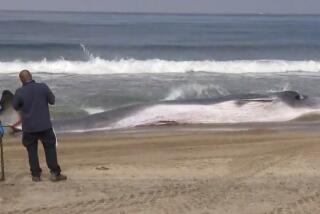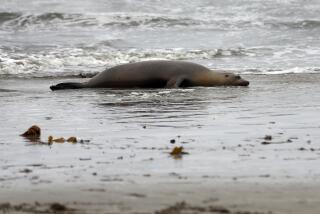Killer Whale a Curious Specimen
People have been watching whales all season, but in the last couple of weeks--a wild and spectacular couple of weeks-- the tide has turned.
Whales, killer whales in particular, have graced Southland shores once again, and they’ve been as curious about whale watchers as whale watchers have been about them.
They’ve swum up to boats, looked people in the eye. They’ve brought their children. They’ve breached free of the water, slapped it with their flukes and, in at least one instance, loitered in prop wash as if enjoying a Jacuzzi.
“They were the most boat-friendly killer whales that I can remember since 1998 with the L.A. pod,” Alisa Schulman-Janiger, a researcher with the American Cetacean Society, said of her encounter Sunday off the Palos Verdes Peninsula.
The killer whales she came across Sunday belong to the “offshore pod,” a mysterious group of perhaps 300 orcas whose range extends at least from northern British Columbia to Orange County.
It should be pointed out that, like the L.A. pod, the offshore pod consists of orcas that are predominantly fish- and squid-eaters. They travel in groups of 25-75. They tend to disappear--perhaps traveling far offshore--for long periods of time and surface close to shore only occasionally.
They were last seen off Orange County in December 1999, off Los Angeles in March 1996.
They resurfaced locally two weeks ago, a mile off Newport Beach, sending wide-eyed whale gazers scrambling to locate them. Those aboard the Sum Fun found them off Dana Point. On March 28, at least 30 killer whales surfaced off San Clemente Island, spotted by fishermen, and last Saturday they were seen by passengers aboard a Catalina Express ferry boat, eight miles east of the island’s isthmus.
On Sunday, they were back in coastal waters, foraging on fish and squid off the peninsula’s Point Vicente. The Van Tuna pulled up alongside them first, followed by the Voyager, First String and a few private vessels.
Schulman-Janiger, aboard a 20-foot boat run by Eric Martin of El Segundo, arrived at 5 p.m. and found the killer whales in small groups spread out over a square mile or so, “just milling around and heading slowly in a west-northwesterly direction,” she said.
One lingered in bubbles caused by the boat’s prop, while another “turned on her side and looked at us.” Two cow-calf pairs were the most intriguing, stopping for a visit and refusing to leave.
“Every time we wanted to move to another group, they would cut us off,” Schulman-Janiger said. “They’d lob-tail [slapping the water with their flukes] to get us to stop, and then they’d approach the boat. When we’d reach certain speeds the calves were playing and porpoising in our wake.”
Schulman-Janiger, Martin and a passenger, Diane Hustad, eventually were able to ditch this group and move on to another, but dusk soon turned to darkness and the jamboree was over.
On Tuesday, about 25 killer whales were seen in the Goleta area, indicating a northbound exodus of the offshore-pod members.
Then on Tuesday, from her perch atop the bluff at Point Vicente, a volunteer for the ACS gray whale census project spotted seven more killer whales. They appeared to be transients from the pod of the same name. Transients are mammal eaters, notorious ambushers of migrating gray whales and fond of other cetaceans as well as pinnipeds.
Joan Venette, a Torrance volunteer, was watching through her binoculars while a humpback whale was lunge-feeding on the surface when she saw orca dorsal fins.
There were seven, swimming swiftly toward shore. There also were dozens of common dolphins, which, when caught in the orcas’ path, sped off in opposite directions.
“Their behavior changed from just milling around to what we call fleeing behavior,” Schulman-Janiger said. “They were traveling at very high speeds in opposite directions, leaping high out of the water and using all of their muscle [to get out of the killer whales’ path].”
Killer whales aren’t the only cetaceans making a splash. A day earlier, Venette watched in awe as two humpback whales breached simultaneously 18 consecutive times.
Schulman-Janiger laughed, but was adamant about the accuracy of the reports when a reporter joked that Venette, having put in 18 years and 11,000 hours at the cliffside vantage point, might have spent too much time in the sun.
*
Anyone with quality photographs of the killer whales, particularly side views of their dorsal fins, is asked to contact Schulman-Janiger at (310) 519-8963, or at janiger@bcf.usc.edu.
She and other researchers, trying to learn more about the movements of the various pods, are involved in an ongoing photo-identification project.
*
Tony Nichols, 41, of Costa Mesa, a member of the Los Angeles chapter of the ACS, made eight trips aboard Orange County vessels in a six-day period in March and recorded nine species of cetaceans.
“It was like a museum out there,” he said.
Nichols’ odyssey began with sightings of humpbacks off Dana Point and Newport Beach on successive days, and ended with the rare sighting of false killer whales off Newport Beach.
Sandwiched between were killer whales (20 of them), gray whales (18), common dolphins (400), bottlenose dolphins (eight), Pacific white-sided dolphins (10), Dall’s porpoise (20) and one fin whale, possibly two.
The fin whale was an adult measuring nearly 60 feet, Nichols said. It found itself in the company of killers and soon thereafter “appeared to be hiding among the boats.”
Most memorable, however, were the false killer whales. They are rarely seen locally and Nichols counted 40, swimming swiftly in groups of four to six off Laguna Beach.
“Another skipper said he saw one with a 20- to 25-pound fish in its mouth,” Nichols said. “He said it looked like a salmon.”
A salmon off Laguna Beach? That’s a rarity in itself.
NEWS AND NOTES
* Saltwater fishing: Barracuda first surfaced off San Diego, then off Huntington Beach and the front side of Catalina Island. No boats have scored big since last Sunday at Huntington Flats but these are signs of an impending invasion that will effectively put an end to the bottom-fishing season. . . . At Catalina, yellowtail have been seen breezing around the front side--an L.A. Harbor Sportfishing vessel returned Tuesday with 30--and white seabass are bunched close to shore on the backside, where poor weather remains their greatest protector. . . . George Castro of Valencia won last weekend’s Marina del Rey Halibut Derby with a catch weighing 26.45 pounds.
* Shipshape: The Southland’s newest commercial sportfisher, the 70-foot Pacific Star, will make its inaugural open-party voyage from Davey’s Locker the night of April 14. The boat, which replaces the Thunderbird at the Newport Beach landing, will be run by primary Capt. Mike Bullard, and will concentrate on island and offshore fishing.
* Reeling and dealing: ESPN has purchased the Bass Anglers Sportsman Society, a Montgomery, Ala., organization with more than 600,000 members and a business profile that includes Bassmaster magazine, the Bassmaster Tournament Trail (20 events) and the Bass Masters Classic.
“This acquisition, together with our expanding commitment to outdoor programming and the Great Outdoor Games, could serve as the foundation for the launch of a dedicated ESPN outdoors network,” George Bondheimer, ESPN president, said in a news release.
* Women in the outdoors: Registration deadline is May 1 for the “Becoming an Outdoors Woman” workshop June 8-10 in Santa Barbara. Sponsored by the Department of Fish and Game and held at Camp Rancho Alegre, “BOW” features hands-on training in a variety of outdoor skills, among them fly fishing, map reading, shotgun and rifle shooting, waterfowl hunting and backpacking. Details: (916) 657-4333, or at https://www.dfg.ca.gov/bow/owoman.html.
WINDING UP
The 976-TUNA Youth Fishing Program, over the years, has treated thousands of underprivileged, inner-city kids to a day on the water. But on Monday, the program turned its attention west--to Santa Catalina Island.
It seems the last place to find children in need of a break from reality, in need of a smile. But those of the island’s many service workers, predominantly Latino, turned out to be just such kids.
You could see it in their faces, program director Philip Friedman said. Many had not been beyond Avalon and their cramped living quarters. Few had explored the shores of their island home and even fewer had cast a line into a sea of dreams.
Aboard the Toronado, during morning and afternoon trips, about 120 third- and fourth-graders did all this and returned with a greater understanding of their incredible surroundings.
“They were excited just to see sea lions,” Friedman said. “They were oohing and aahing at everything we saw, things we take for granted.”
Most of the kids caught perch, calico bass, sheephead and whitefish, and being so young and appreciative of the lively and colorful creatures at the end of their lines, they instructed the adult volunteers to throw them all back.


